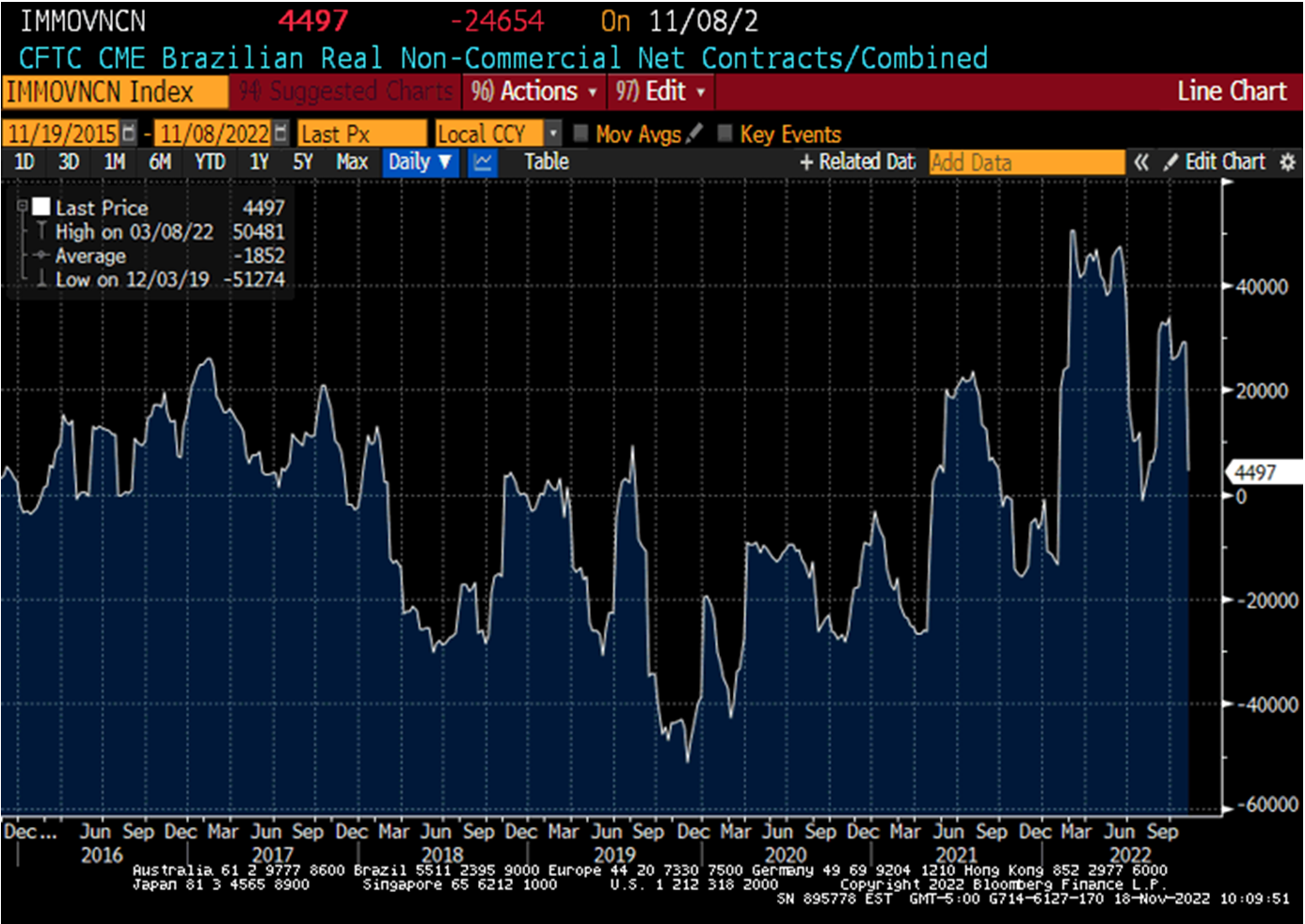Economic Policies – Keep It Simple
18 November 2022
Read Time 2 MIN
Brazil Fiscal Debates
I learned two new economic terms this week - “macrosynergy” and “quantamental”. They sound remarkably clever, but simple concepts/frameworks work just fine most of the time. For example, if you mess up with fiscal accounts – your bonds and the currency get hit. One of my Twitter counterparts “demanded” a multi-factor attribution analysis of Brazil’s relative underperformance after the runoff (R-squares and stuff), but I think it boils down to the fact that the market had high expectations (President-elect Lula-the-pragmatist), which got crushed by reality (Lula-the-populist pushing for more spending). The market’s elevated positioning in Brazil started to clear off after Lula’s victory (see chart below for net longs in the Brazilian real), but there is still room for further unwinding, if policy uncertainty continues. So, we keep watching Brazil’s fiscal debates as hawks. The probability of a “warning shot” from the Brazilian central bank (ending the pause and raising the policy rate) is getting higher in this environment.
EM Growth and Current Account Gaps
Brazil’s saving grace is its external metric – huge international reserves and a basic balance surplus (a sum of current account and foreign direct investments). But one regional example shows what could happen when there is too much domestic stimulus amidst slowing external demand. The Chilean economy already started to cool – it posted negative sequential and flat annual GDP growth in Q3 – but imports (fueled by multiple withdrawals from private pension funds) are still at multi-decade highs. As a result, the trailing current account deficit widened to nearly 10% of GDP in Q3. The consensus expects Chile to slide into recession in 2023, which should help to reduce the current account gap. However, Chile’s ability to maintain its fiscal discipline will matter even more against this backdrop – double-digit financing requirements can send a bad signal to the bond market.
EM External Balances
Chile’s current account deterioration is not the only cautionary tale – wider external gaps in Central Europe and Turkey are also concerning. South Africa’s current account posted a surprising deficit (1.3% of GDP) in Q2 – a potential challenge for the central bank, which had already accelerated the pace of rate hikes. However, there are also “comeback kid” stories in EM – Thailand’s current account flipped into surplus in September, and the consensus expects a healthy surplus of 2.2% of GDP in 2023 (and an even larger surplus in 2024). Indonesia’s current account surplus surprised to the upside in Q3, widening to USD4.4B, providing a nice fundamental support for the currency (in addition to the central bank’s proactive tightening). Stay tuned!
Chart at a Glance: Brazil – Great Expectations… Crushed?

Source: Bloomberg LP.
* GSCPI Index: Global Supply Chain Pressure Index seeks to measure supply chain conditions, created by the Federal Reserve. The index combines variables from several indices in transportation and manufacturing
Related Insights
IMPORTANT DEFINITIONS & DISCLOSURES
This material may only be used outside of the United States.
This is not an offer to buy or sell, or a recommendation of any offer to buy or sell any of the securities mentioned herein. Fund holdings will vary. For a complete list of holdings in VanEck Mutual Funds and VanEck ETFs, please visit our website at www.vaneck.com.
The information presented does not involve the rendering of personalized investment, financial, legal, or tax advice. Certain statements contained herein may constitute projections, forecasts and other forward looking statements, which do not reflect actual results. Information provided by third-party sources are believed to be reliable and have not been independently verified for accuracy or completeness and cannot be guaranteed. Any opinions, projections, forecasts, and forward-looking statements presented herein are valid as of the date of this communication and are subject to change without notice. The information herein represents the opinion of the author(s), but not necessarily those of VanEck.
The views contained herein are not to be taken as advice or a recommendation to buy or sell any investment in any jurisdiction, nor is it a commitment from Van Eck Associates Corporation or its subsidiaries to participate in any transactions in any companies mentioned herein. This content is published in the United States. Investors are subject to securities and tax regulations within their applicable jurisdictions that are not addressed herein.
All investing is subject to risk, including the possible loss of the money you invest. As with any investment strategy, there is no guarantee that investment objectives will be met and investors may lose money. Diversification does not ensure a profit or protect against a loss in a declining market. Past performance is no guarantee of future results.
